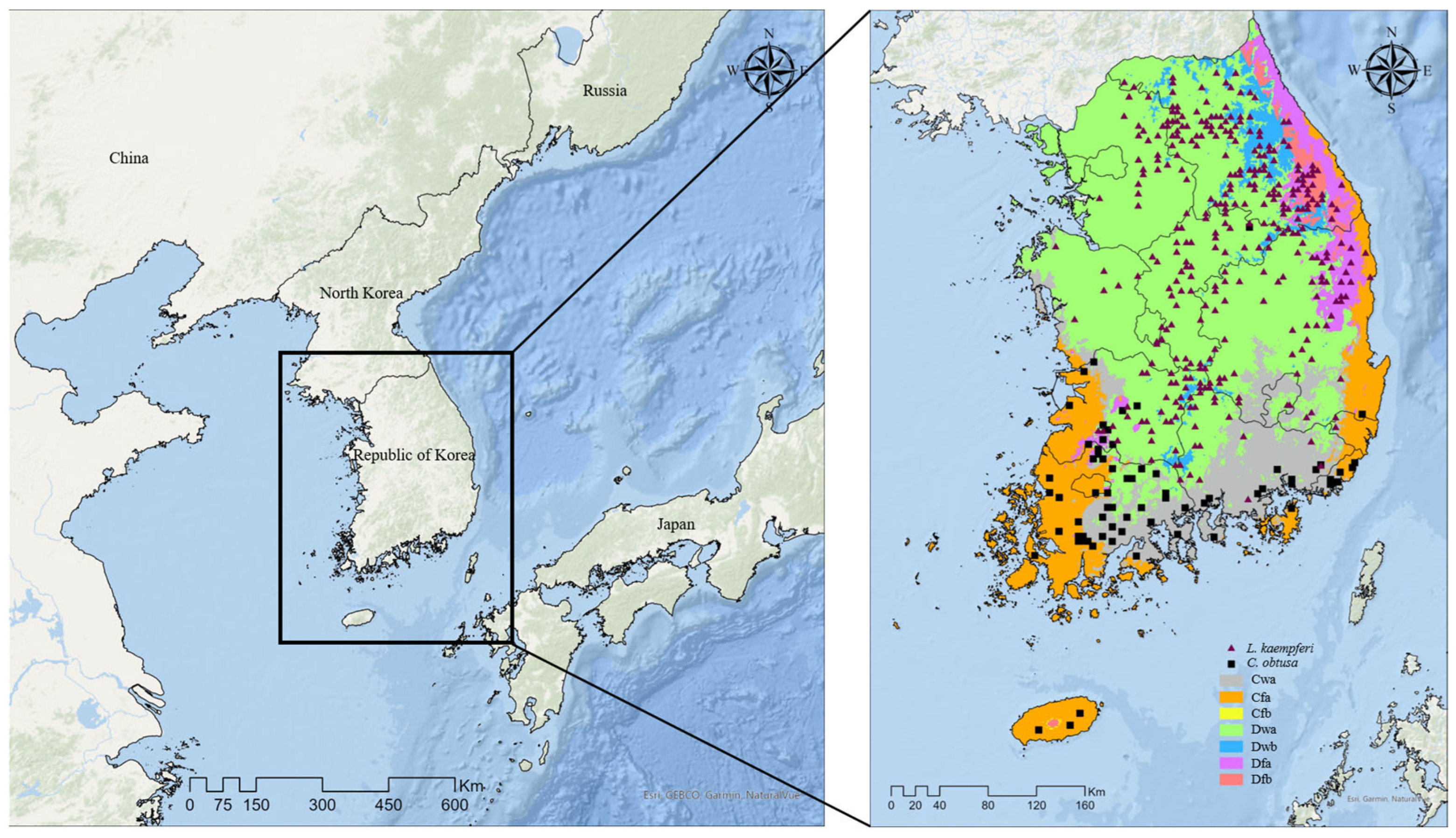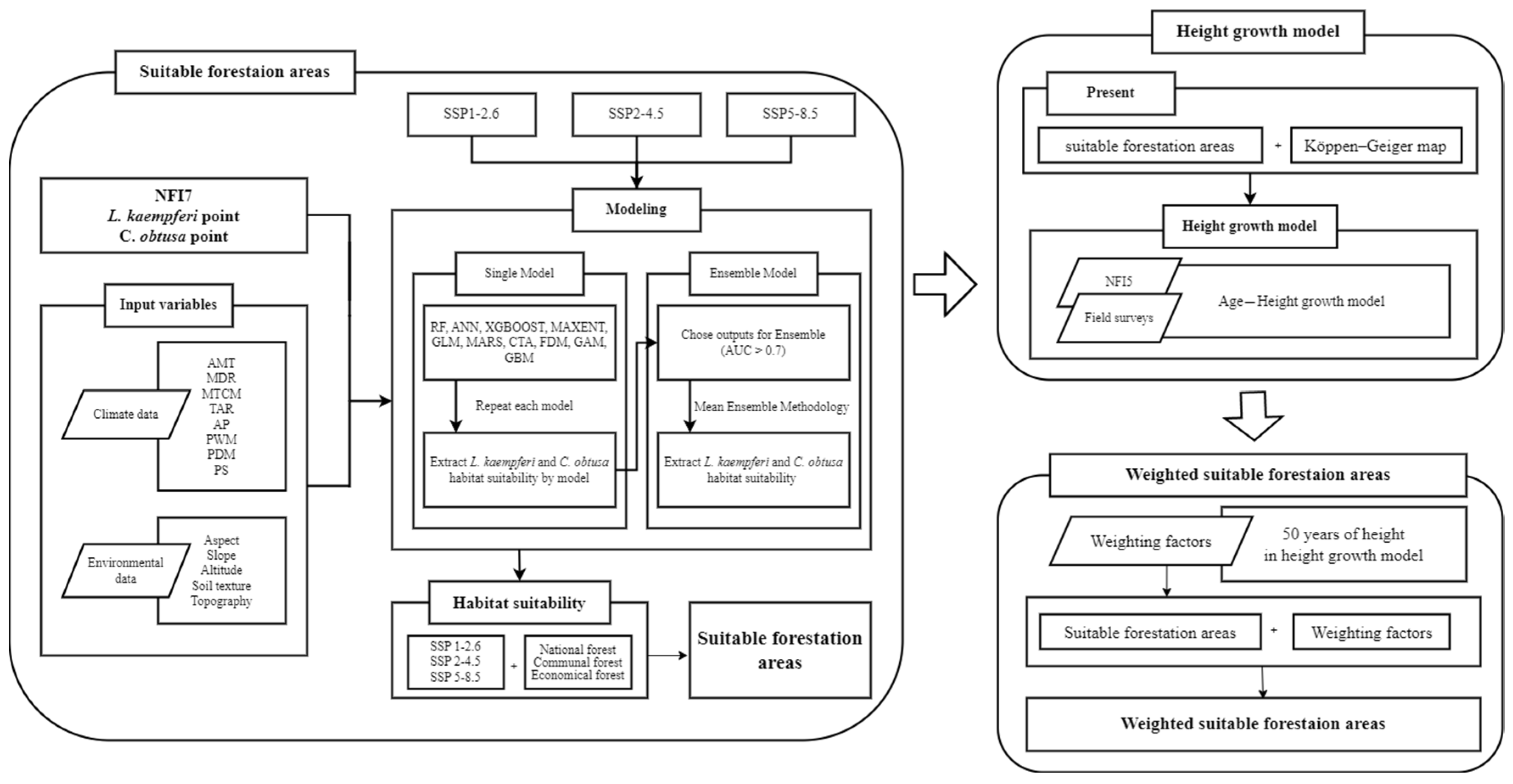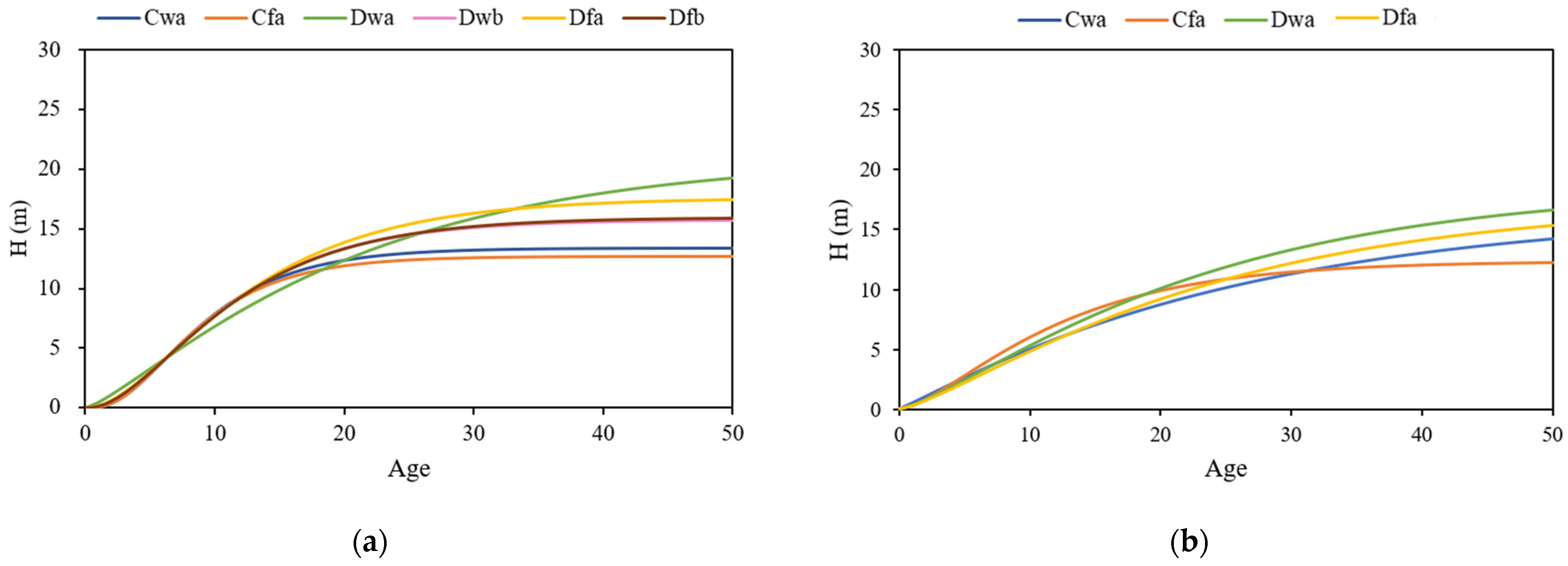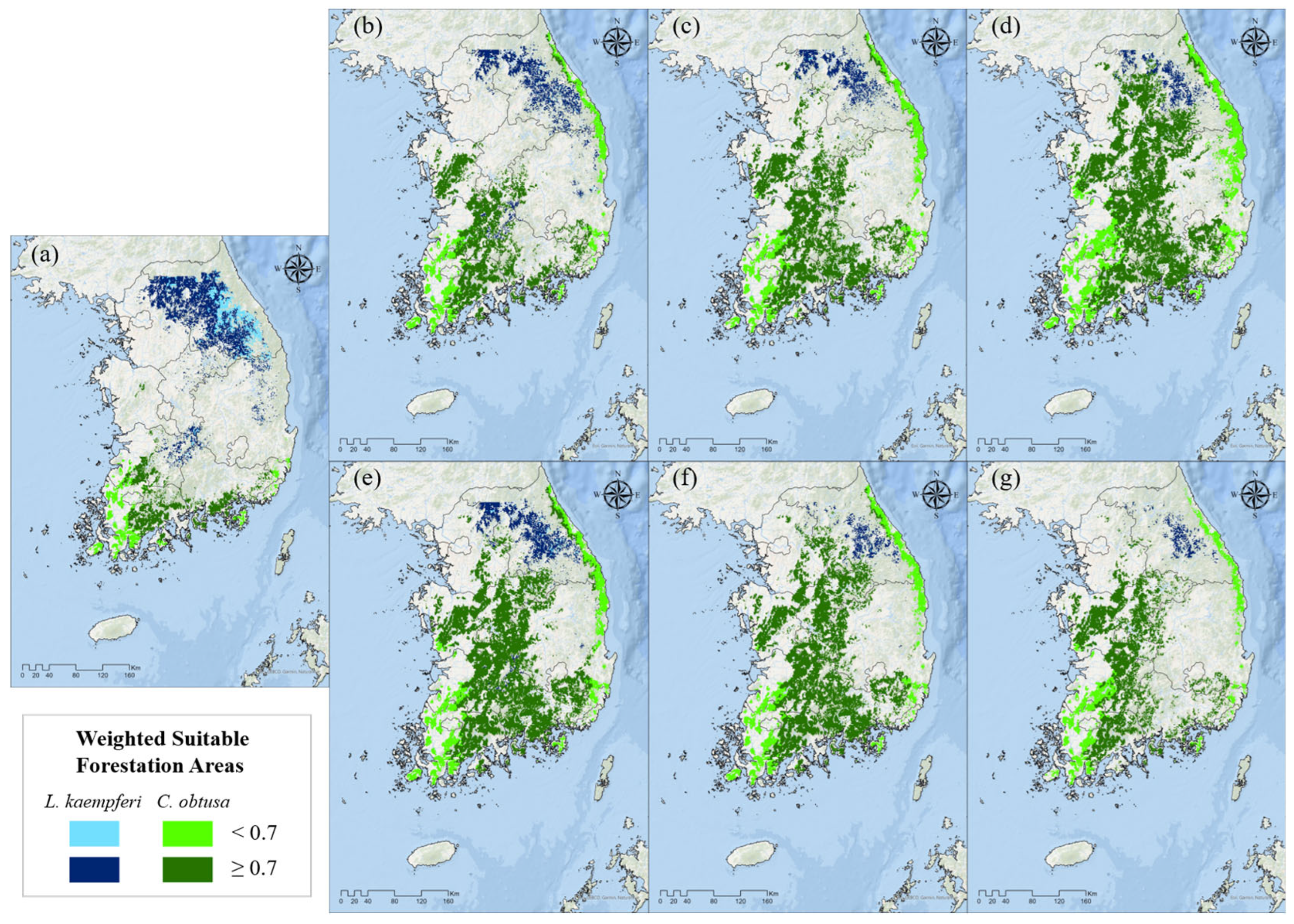Exploring the Climate-Suitable Forestation Area Under Species Distribution and Growth Modeling for Larix kaempferi and Chamaecyparis obtusa in the Republic of Korea
Abstract
1. Introduction
2. Materials and Methods
2.1. Study Area
2.2. Research Process for Present Study
2.3. Suitable Forestation Area (SFA)
2.3.1. Machine Learning Ensembles
2.3.2. Input Data
2.4. Growth Model Development
2.5. Climate-Weighted SFA
3. Results
3.1. Changes in Forestation Suitability Under Climate Change
3.2. Development of Growth Models for Climatic Zones
3.3. Predicting Future Forestation Areas Using Weighted Growth Models
4. Discussion
4.1. Vulnerability of L. kaempferi and Adaptability of C. obtusa to Climate Change
4.2. Growth Patterns Between Climatic Zones
4.3. Implications of SFA and WSFA Analysis for Sustainable Forest Management
4.4. Limitations and Future Research Directions
5. Conclusions
Author Contributions
Funding
Data Availability Statement
Conflicts of Interest
References
- Keenan, R.J. Climate change impacts and adaptation in forest management: A review. Ann. For. Sci. 2015, 72, 145–167. [Google Scholar] [CrossRef]
- Jo, H.-S.; Lee, S.-M. Quantification of the Forest Ecosystem Components and Services. J. Fish. Mar. Sci. Educ. 2016, 28, 391–400. [Google Scholar] [CrossRef][Green Version]
- Gebeyehu, M.N. Review on Effect of Climate Change on Forest Ecosystem. Int. J. Environ. Sci. Nat. Resour. 2019, 17, 126–129. [Google Scholar] [CrossRef]
- Park, S.-G.; Kang, H.-M. Characteristics of Vegetation Structure in Chamaecyparis obtusa stands. Korean J. Environ. Ecol. 2015, 29, 907–916. [Google Scholar] [CrossRef]
- Sun, C.; Xie, Y.H.; Li, Z.; Liu, Y.J.; Sun, X.M.; Li, J.J.; Quan, W.P.; Zeng, Q.Y.; Van de Peer, Y.; Zhang, S.G. The Larix kaempferi genome reveals new insights into wood properties. J. Integr. Plant Biol. 2022, 64, 1364–1373. [Google Scholar] [CrossRef]
- Korea Forest Service. Afforestation Business Performance Report; Korea Forest Service: Daejon, Republic of Korea, 2021.
- Han, S.-H.; Kim, D.-H.; Kim, G.-N.; Lee, J.-C.; Yun, C.-W. Changes on Initial Growth and Physiological Characteristics of Larix kaempferi and Betula costata Seedlings under Elevated Temperature. Korean J. Agric. For. Meteorol. 2012, 14, 63–70. [Google Scholar] [CrossRef]
- Son, H.-J.; Kim, Y.-S.; Kim, N.-Y.; Lee, H.-B.; Park, W.-G. A Consideration of the Possibility of Planting Cryptomeria japonica and Chamaecyparis obtusa on the East Sea Area in Gangwon-Province by Tree Ring Dating and Climatic Factor Analysis. J. For. Environ. Sci. 2014, 30, 36–44. [Google Scholar] [CrossRef][Green Version]
- Hao, T.; Elith, J.; Guillera-Arroita, G.; Lahoz-Monfort, J.J.; Serra-Diaz, J. A review of evidence about use and performance of species distribution modelling ensembles like BIOMOD. Divers. Distrib. 2019, 25, 839–852. [Google Scholar] [CrossRef]
- Elith, J.; Graham, C.H.; Anderson, R.P.; Dudík, M.; Ferrier, S.; Guisan, A.; Hijmans, R.J.; Huettmann, F.; Leathwick, J.R.; Lehmann, A.; et al. Novel methods improve prediction of species’ distributions from occurrence data. Ecography 2006, 29, 129–151. [Google Scholar] [CrossRef]
- Meller, L.; Cabeza, M.; Pironon, S.; Barbet-Massin, M.; Maiorano, L.; Georges, D.; Thuiller, W. Ensemble distribution models in conservation prioritization: From consensus predictions to consensus reserve networks. Divers. Distrib. 2013, 20, 309–321. [Google Scholar] [CrossRef]
- Guisan, A.; Thuiller, W. Predicting species distribution: Offering more than simple habitat models. Ecol. Lett. 2005, 8, 993–1009. [Google Scholar] [CrossRef] [PubMed]
- Cassini, M.H. Ecological principles of species distribution models: The habitat matching rule. J. Biogeogr. 2011, 38, 2057–2065. [Google Scholar] [CrossRef]
- Anderson-Teixeira, K.J.; Herrmann, V.; Rollinson, C.R.; Gonzalez, B.; Gonzalez-Akre, E.B.; Pederson, N.; Alexander, M.R.; Allen, C.D.; Alfaro-Sánchez, R.; Awada, T. Joint effects of climate, tree size, and year on annual tree growth derived from tree-ring records of ten globally distributed forests. Glob. Change Biol. 2022, 28, 245–266. [Google Scholar] [CrossRef] [PubMed]
- Carneiro, L.R.; Lima, A.P.; Machado, R.B.; Magnusson, W.E. Limitations to the Use of Species-Distribution Models for Environmental-Impact Assessments in the Amazon. PLoS ONE 2016, 11, e0146543. [Google Scholar] [CrossRef]
- Lee-Yaw, J.A.; McCune, J.L.; Pironon, S.; Sheth, S.N. Species distribution models rarely predict the biology of real populations. Ecography 2021, 2022, e05877. [Google Scholar] [CrossRef]
- Adhikari, B.; Subedi, S.C.; Bhandari, S.; Baral, K.; Lamichhane, S.; Maraseni, T. Climate-driven decline in the habitat of the endemic spiny babbler (Turdoides nipalensis). Ecosphere 2023, 14. [Google Scholar] [CrossRef]
- Dyderski, M.K.; Paź, S.; Frelich, L.E.; Jagodziński, A.M. How much does climate change threaten European forest tree species distributions? Glob. Change Biol. 2018, 24, 1150–1163. [Google Scholar] [CrossRef]
- Alegria, C.; Almeida, A.M.; Roque, N.; Fernandez, P.; Ribeiro, M.M. Species distribution modelling under climate change scenarios for maritime pine (Pinus pinaster Aiton) in Portugal). Forests 2023, 14, 591. [Google Scholar] [CrossRef]
- Beck, H.E.; McVicar, T.R.; Vergopolan, N.; Berg, A.; Lutsko, N.J.; Dufour, A.; Zeng, Z.; Jiang, X.; van Dijk, A.; Miralles, D.G. High-resolution (1 km) Koppen-Geiger maps for 1901-2099 based on constrained CMIP6 projections. Sci. Data 2023, 10, 724. [Google Scholar] [CrossRef]
- Ahn, H.-G.; Lim, C.-H. Assessing habitat suitability for timber species in South Korea under SSP scenarios. Environ. Biol. Res. 2022, 40, 567–578. [Google Scholar] [CrossRef]
- Noce, S.; Collalti, A.; Santini, M. Likelihood of changes in forest species suitability, distribution, and diversity under future climate: The case of Southern Europe. Ecol. Evol. 2017, 7, 9358–9375. [Google Scholar] [CrossRef] [PubMed]
- Ahn, H.K.; Jung, H.; Lim, C.-H. Can Ensemble Techniques and Large-Scale Fire Datasets Improve Predictions of Forest Fire Probability Due to Climate Change?—A Case Study from the Republic of Korea. Forests 2024, 15, 503. [Google Scholar] [CrossRef]
- West, A.M.; Kumar, S.; Brown, C.S.; Stohlgren, T.J.; Bromberg, J. Field validation of an invasive species Maxent model. Ecol. Inform. 2016, 36, 126–134. [Google Scholar] [CrossRef]
- Hijmans, R.J.; Phillips, S.; Leathwick, J.; Elith, J. Package ‘dismo’. R Package Version. 2017, 9, pp. 1–68. Available online: https://rspatial.org/raster/sdm/ (accessed on 11 March 2025).
- Kreyling, J. Winter climate change: A critical factor for temperate vegetation performance. Ecology. 2010, 91, 1939–1948. [Google Scholar] [CrossRef] [PubMed]
- Harsch, M.A.; Hulme, P.E.; McGlone, M.S.; Duncan, R.P. Are treelines advancing? A global meta-analysis of treeline response to climate warming. Ecol. Lett. 2009, 12, 1040–1049. [Google Scholar] [CrossRef]
- Hagedorn, F.; Shiyatov, S.G.; Mazepa, V.S.; Devi, N.M.; Grigor’ev, A.A.; Bartysh, A.A.; Fomin, V.V.; Kapralov, D.S.; Terent’ev, M.; Bugman, H.; et al. Treeline advances along the Urals mountain range-driven by improved winter conditions? Glob. Change Biol. 2014, 20, 3530–3543. [Google Scholar] [CrossRef]
- Hijmans, R.J.; Cameron, S.E.; Parra, J.L.; Jones, P.G.; Jarvis, A. Very high resolution interpolated climate surfaces for global land areas. Int. J. Climatol. 2005, 25, 1965–1978. [Google Scholar] [CrossRef]
- Somers, G.L.; Farrar, R.M. Biomathematical Growth Equations for Natural Longleaf Pine Stand. For. Sci. Technol. 1991, 3, 227–244. [Google Scholar] [CrossRef]
- Pyo, J. Developing the site index equation using a generalized algebraic difference approach for Pinus densiflora in central region, Korea. For. Sci. Technol. 2017, 13, 87–91. [Google Scholar] [CrossRef]
- Peng, C.; Zhang, L.; Liu, J. Developing and Validating Nonlinear Height–Diameter Models for Major Tree Species of Ontario’s Boreal Forests. North. J. Appl. For. 2001, 18, 87–94. [Google Scholar] [CrossRef]
- Lumbres, R.I.C.; Seo, Y.O.; Son, Y.M.; Doyog, N.D.; Lee, Y.J. Height-age model and site index curves for Acacia mangium and Eucalyptus pellitain Indonesia. For. Sci. Technol. 2018, 14, 91–96. [Google Scholar] [CrossRef]
- Fourcade, Y.; Engler, J.O.; Rodder, D.; Secondi, J. Mapping species distributions with MAXENT using a geographically biased sample of presence data: A performance assessment of methods for correcting sampling bias. PLoS ONE 2014, 9, e97122. [Google Scholar] [CrossRef] [PubMed]
- Wu, C.; Shen, J.; Chen, D.; Du, C.; Sun, X.; Zhang, S. Estimating the distribution characters of Larix kaempferi in response to climate change. iForest—Biogeosci. For. 2020, 13, 499–506. [Google Scholar] [CrossRef]
- Mamet, S.D.; Brown, C.D.; Trant, A.J.; Laroque, C.P. Shifting global Larix distributions: Northern expansion and southern retraction as species respond to changing climate. J. Biogeogr. 2018, 46, 30–44. [Google Scholar] [CrossRef]
- Korea Forest Research Institute. Predicting the Changes of Productive Areas for Major Tree Species Under Climate Change in Korea; Korea Forest Research Institute: Seoul, Republic of Korea, 2014.
- Nagakura, J.; Shigenaga, H.; Akama, A.; Takahashi, M. Growth and transpiration of Japanese cedar (Cryptomeria japonica) and Hinoki cypress (Chamaecyparis obtusa) seedlings in response to soil water content. Tree Physiol. 2004, 24, 1203–1208. [Google Scholar] [CrossRef]
- Osone, Y.; Hashimoto, S.; Kenzo, T. Verification of our empirical understanding of the physiology and ecology of two contrasting plantation species using a trait database. PLoS ONE 2021, 16, e0254599. [Google Scholar] [CrossRef]
- Shik, M.H.; Solomon, T. The growth pattern of Chamaecyparis obtuse stand along longevity in Gyeongnam Province, South Korea. Open J. For. 2020, 10, 377–387. [Google Scholar] [CrossRef]
- Stirling, C.M.; Heddell-Cowie, M.; Jones, M.L.; Ashenden, T.W.; Sparks, T.H. Effects of elevated CO2 and temperature on growth and allometry of five native fast-growing annual species. New Phytol. 1998, 140, 343–354. [Google Scholar] [CrossRef]
- Song, W.K.; Park, G.E.; Je, S.M.; Kim, S.H.; Lim, J.-H. Growth and Physiological Characteristics of Abies koreana, Pinus densiflora, Quercus serrata Seedlings under Elevated Temperature and CO2 Concentration. J. Clim. Change Res. 2020, 11, 1–9. [Google Scholar] [CrossRef]
- Wang, C.; Li, P.; Xiao, T.; Bai, T.; Deng, W.; Liu, Y. Effects of climate change and forest gap disturbance on the growth characteristics of Japanese cypress and Japanese cedar on Mount Lushan, subtropical China. J. Soils Sediments 2024, 24, 1528–1540. [Google Scholar] [CrossRef]
- Adu-Bredu, S.; Yokota, T.; Hagihara, A. Temperature effect on maintenance and growth respiration coefficients of young, field-grown hinoki cypress (Chamaecyparis obtusa). Ecol. Res. 1997, 12, 357–362. [Google Scholar] [CrossRef]
- Yang, A.R.; Hwang, J.; Cho, M.S. Regional Early Growth Performances of Planted Chamaecyparis obtusa Seedlings in Relation to Site Properties. J. Korean For. Soc. 2014, 103, 375–382. [Google Scholar] [CrossRef]





| Letter Symbol | ||||
|---|---|---|---|---|
| 1st | 2nd | 3rd | Description | Criteria a |
| C | Temperate climate | Thot > 10 and 0 < Tcold < 18 | ||
| D | Continental climate | Thot > 10 and Tcold ≤ 0 | ||
| w | Dry winter | Pwdry < Pswet/10 | ||
| f | Without dry season | Not (Dw) | ||
| a | Hot summer | Thot ≥ 22 | ||
| b | Warm summer | Not (a) and Tmon10 ≥ 4 | ||
| Variable Type | Variable | Abbreviation | Source |
|---|---|---|---|
| Climate data | Annual mean temperature | AMT | Korea Meteorological Administration |
| Mean diurnal range | MDR | ||
| Minimum temperature of coldest month | MTCM | ||
| Temperature annual range | TAR | ||
| Annual precipitation | AP | ||
| Precipitation of wettest month | PWM | ||
| Precipitation of driest month | PDM | ||
| Precipitation of seasonality | PS | ||
| Environmental data | Aspect | DEM | |
| Slope | |||
| Altitude | |||
| Soil texture | Forest Soil Map (1:25,000) | ||
| Topography |
| Variable Type | Variable | L. kaempferi | C. obtusa |
|---|---|---|---|
| Climate data | Annual mean temperature | 0.0283 | 0.1805 |
| Mean diurnal range | 0.0345 | 0.0053 | |
| Minimum temperature of coldest month | 0.3677 | 0.0158 | |
| Temperature annual range | 0.0779 | 0.0060 | |
| Annual precipitation | 0.0105 | 0.0373 | |
| Precipitation of wettest month | 0.0268 | 0.1012 | |
| Precipitation of driest month | 0.0239 | 0.3000 | |
| Precipitation of seasonality | 0.2304 | 0.2525 | |
| Environmental data | Aspect | 0.0113 | 0.0015 |
| Slope | 0.0024 | 0.0009 | |
| Altitude | 0.0655 | 0.1700 | |
| Soil texture | 0.0262 | 0.0004 | |
| Topography | 0.0146 | 0.0019 |
| Species | Climate Zone | Parameters | R2 | ||
|---|---|---|---|---|---|
| a | b | c | |||
| L. kaempferi | Cwa | 13.4142 | 0.1823 | 3.0137 | 0.9023 |
| Cfa | 12.6707 | 0.1953 | 3.1693 | 0.9083 | |
| Dwa | 20.9915 | 0.0547 | 1.2992 | 0.9733 | |
| Dwb | 15.7226 | 0.1340 | 2.3367 | 0.9320 | |
| Dfa | 17.5437 | 0.1110 | 2.0653 | 0.9418 | |
| Dfb | 15.9347 | 0.1289 | 2.2608 | 0.9104 | |
| C. obtusa | Cwa | 16.6153 | 0.0402 | 1.0856 | 0.9601 |
| Cfa | 12.3964 | 0.1033 | 1.6443 | 0.8544 | |
| Dwa | 18.6098 | 0.0509 | 1.3686 | 0.9568 | |
| Dfa | 17.3223 | 0.0494 | 1.3599 | 0.9769 | |
| Species | SSP1-2.6 | SSP2-4.5 | SSP5-8.5 | |||||
|---|---|---|---|---|---|---|---|---|
| 2020s | 2050s | 2090s | 2050s | 2090s | 2050s | 2090s | ||
| L. kaempferi | SFA | 10,765 | 4860 | 4089 | 2876 | 1467 | 1951 | 1142 |
| WSFA | 8210 | 4712 | 3916 | 2815 | 1441 | 1912 | 1109 | |
| C. obtusa | SFA | 6677 | 16,501 | 29,905 | 23,101 | 28,149 | 34,348 | 19,033 |
| WSFA | 4324 | 11,943 | 24,214 | 17,417 | 22,681 | 25,692 | 14,217 | |
Disclaimer/Publisher’s Note: The statements, opinions and data contained in all publications are solely those of the individual author(s) and contributor(s) and not of MDPI and/or the editor(s). MDPI and/or the editor(s) disclaim responsibility for any injury to people or property resulting from any ideas, methods, instructions or products referred to in the content. |
© 2025 by the authors. Licensee MDPI, Basel, Switzerland. This article is an open access article distributed under the terms and conditions of the Creative Commons Attribution (CC BY) license (https://creativecommons.org/licenses/by/4.0/).
Share and Cite
Lee, D.-H.; Ahn, H.K.; Shin, H.D.; Lee, J.-G.; Lim, C.-H.; Kim, H.-J. Exploring the Climate-Suitable Forestation Area Under Species Distribution and Growth Modeling for Larix kaempferi and Chamaecyparis obtusa in the Republic of Korea. Forests 2025, 16, 530. https://doi.org/10.3390/f16030530
Lee D-H, Ahn HK, Shin HD, Lee J-G, Lim C-H, Kim H-J. Exploring the Climate-Suitable Forestation Area Under Species Distribution and Growth Modeling for Larix kaempferi and Chamaecyparis obtusa in the Republic of Korea. Forests. 2025; 16(3):530. https://doi.org/10.3390/f16030530
Chicago/Turabian StyleLee, Du-Hee, Hyeon Kwon Ahn, Han Doo Shin, Jeong-Gwan Lee, Chul-Hee Lim, and Hyun-Jun Kim. 2025. "Exploring the Climate-Suitable Forestation Area Under Species Distribution and Growth Modeling for Larix kaempferi and Chamaecyparis obtusa in the Republic of Korea" Forests 16, no. 3: 530. https://doi.org/10.3390/f16030530
APA StyleLee, D.-H., Ahn, H. K., Shin, H. D., Lee, J.-G., Lim, C.-H., & Kim, H.-J. (2025). Exploring the Climate-Suitable Forestation Area Under Species Distribution and Growth Modeling for Larix kaempferi and Chamaecyparis obtusa in the Republic of Korea. Forests, 16(3), 530. https://doi.org/10.3390/f16030530







